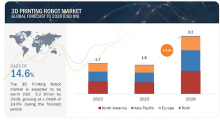Despite rising inflation rates, the demand for eyewear remains consistent. The Vision Council’s Consumer inSights report for the second quarter of 2023 revealed that 80% of surveyed consumers use vision-correction tools. Among those who wear prescription glasses, more than half made a purchase within the past 12 months.
A critical factor in meeting these consumer needs is the growing use of advanced technologies for eyewear marketing, manufacturing, and distribution. Specifically, industry applications of robotics and artificial intelligence can play a substantial role in boosting sales and the overall customer experience. This paints an optimistic picture for the global eyewear market in the coming years.
Robots and automation modernize supply chains
Robotics and automation have been instrumental in modernizing the supply chain, starting with design and manufacturing. For example, Materialise NV and Ditto have partnered to introduce 3D printing to the eyewear industry.
With a focus on developing end-to-end platforms, this collaboration and others seek to use additive manufacturing to speed up production time and stay on top of fashion trends without investing in additional tooling. Since 3D-printed eyewear can be manufactured in small batches, it can also be used to deliver more precise, unique, and personalized designs to the consumer base.
Robotics applications also extend into the final step of the supply chain, which is order processing and fulfillment. To meet increasing customer production targets in line with e-commerce expansions, robotics developer OSARO collaborated with Zenni Optical to deploy robotic bagging systems at the retailer’s order-fulfillment center.
Although bagging and labeling orders correctly are highly complex tasks, the robots are coupled with machine learning capabilities to ensure high-speed precision, dexterity, and accuracy. This cutting-edge technology can help e-commerce retailers like Zenni address labor turnover, staff shortage, and increased demand all at the same time.
AI tools elevate eyewear customer experience
The adoption of digital distribution channels within eyewear value chains has significantly transformed the shopping experience. More and more customers purchase eyewear online, encouraging optical retailers to innovate their digital platforms with AI tools.
For instance, Zenni Optical has announced two new technological offerings that allow customers to easily find and buy suitable frames from a catalog of over 3,000 options. The first is a website and in-app Image Search tool where customers can upload a photo of preferred frames and find similar versions offered by Zenni.
The other offering is a prescription reader called Prescription Scan, which enables customers to upload their prescription details and skip manual entry.
In addition, the AI and e-commerce revolution can enhance the customer purchase and discovery process by mirroring the in-person shopping experience. Optical retailer EyeBuyDirect has a website feature that lets customers try on glasses online after hovering over a product image.
The virtual try-on feature can be used in real-time via camera preview or by uploading an image. AI and augmented reality (AR) promise to help customers experiment with various frame styles. They can preview the frame size and fit on their faces before placing an order.
Overall, these AI-powered tools can smooth over friction points in digital channels and increase customers’ confidence in their online purchases.

Eyewear manufacturers and retailers are further using technological advancements for customer experience through data science and analytics. For example, e-commerce platforms use heat maps to analyze user behavior and reduce the amount of time and clicks throughout the consumer decision journey.
AI and robotics can also help exclusively online retailers set themselves apart from their brick-and-mortar counterparts in terms of the level of customer personalization and operational efficiency. Companies need only find and implement the right digital tools that are scalable and cost-effective without compromising the overall customer experience.
About the author
Corinne Roy is a freelance writer with a focus on tech and business. Her areas of interest are new technology, AI, e-commerce, and agile business practices.
Article topics
Email Sign Up


















